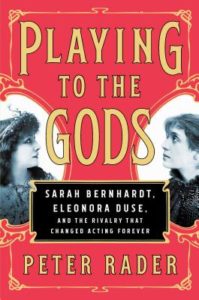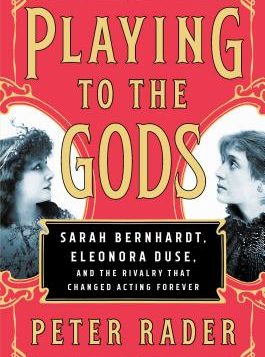 Playing to the Gods: Sarah Bernhardt, Eleonora
Playing to the Gods: Sarah Bernhardt, Eleonora
Duse, and the Rivalry That Changed Acting Forever
by Peter Rader
Simon & Schuster. 275 pages, $26.
THE TITLE of this book is an exaggeration that grows out of another exaggeration that is this book’s thesis: that Sarah Bernhardt typified an “old school” of unnatural stage acting that consisted of moving from one stylized pose to the next, while Duse introduced a new, realistic style that actors have adopted ever since, hence “changing acting forever.” Bernhardt relied on lavish productions about bigger-than-life historical figures; Duse played simple, usually contemporary women. Bernhardt used overly dramatic declamation, Duse meaningful pauses and half-whispered lines. And so on.
This is mostly unfair to theater history. Actors have chosen between the grand, declamatory style or a more intimate, personal one since at least the 17th century, if not before, and continue to do so today. I can remember seeing Racine’s Brittanicusat the Comédie-Française, France’s state theater, for example, and being amazed as the actor playing Néro portrayed him in a relatively intimate, “realistic” style, while the other thespians, generations after Bernhardt and Duse, declaimed their verse to the upper galleries (where I was sitting) as if they were in an oratory contest. Duse’s “natural” style was certainly remarked upon, as Rader shows, but she was not the first to act that way. Indeed, Rader himself mentions that some of her contemporaries, like Ellen Terry, were doing the same thing. There had been other “natural” actors before her.
This artificial antithesis is specifically unfair to Bernhardt. In Paris she certainly played larger-than-life historical figures with grand gestures in front of lavish sets. But outside the capital she undertook peasant women in productions that were not lavish or richly costumed—while joking that she could not play them in Paris because Parisians wanted to see her with all her jewels. It’s true that our few, very poor recordings of Bernhardt’s voice suggest an over-the-top, lachrymose style that was far from natural—or at least what passes for natural in a theater. There are also reports, however, including some quoted by Rader, that suggest she sometimes performed in a more intimate, personal style as well—a style that early acoustic recording could not have captured. Like any other serious actress, she seems to have varied her style with the roles she played and the quality of the play in which she appeared. And she appeared in plays of greatly varying quality, from Sardou’s historical melodramas to the masterpieces of Racine. It’s also hard to imagine Duse performing some of D’Annunzio’s over-the-top historical dramas, like Francesca da Rimini, in anything less than a declamatory style. In her one movie, Cenere (1916), Duse moves much like other silent screen actresses, with large gestures.
All this is not to say that Rader’s book is of no interest. The first half is devoted to parallel lives of the two actresses through their early years in the theater. It includes brief mention of their affairs with other women. Then, once Bernhardt travels to London in 1894 to see Duse perform in one of the plays that Bernhardt had made famous, Alexander Dumas Jr.’s The Lady of the Camellias, Rader spends the second half of his text, definitely the more interesting, arguing that each artist developed her subsequent career at least in part in response to her rival. I would have liked more quotations from the actresses’ diaries or letters to support Rader’s interpretations of these actions, but perhaps they don’t exist. Still, the story of these two great figures of early 20th-century theater plotting to outdo each other is fun reading and makes this book worthwhile despite the exaggerated thesis.
_____________________________________________________________
Richard M. Berrong is professor of French literature at Kent State U.






